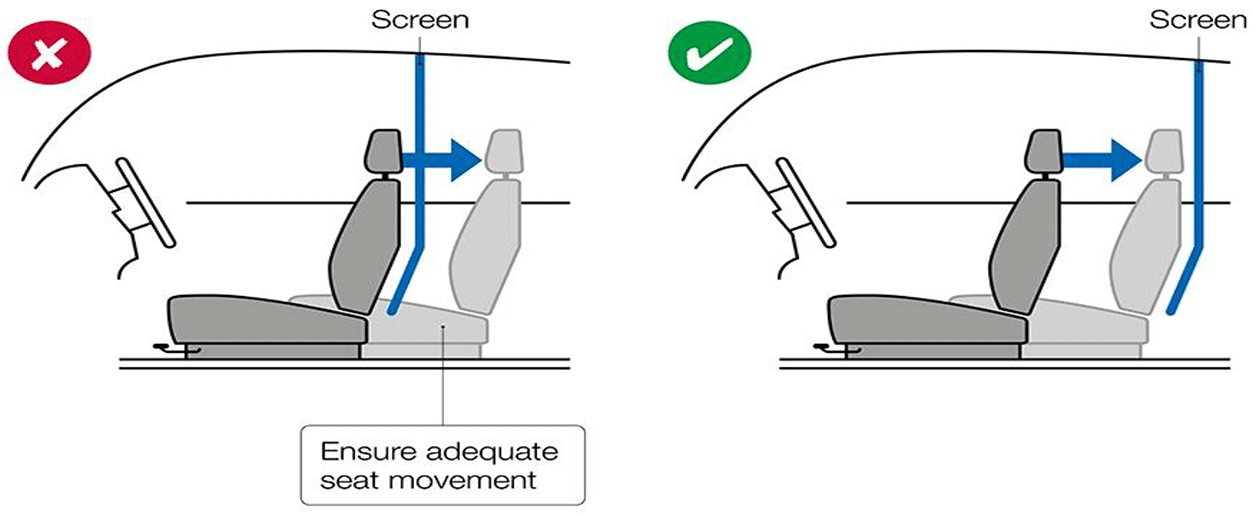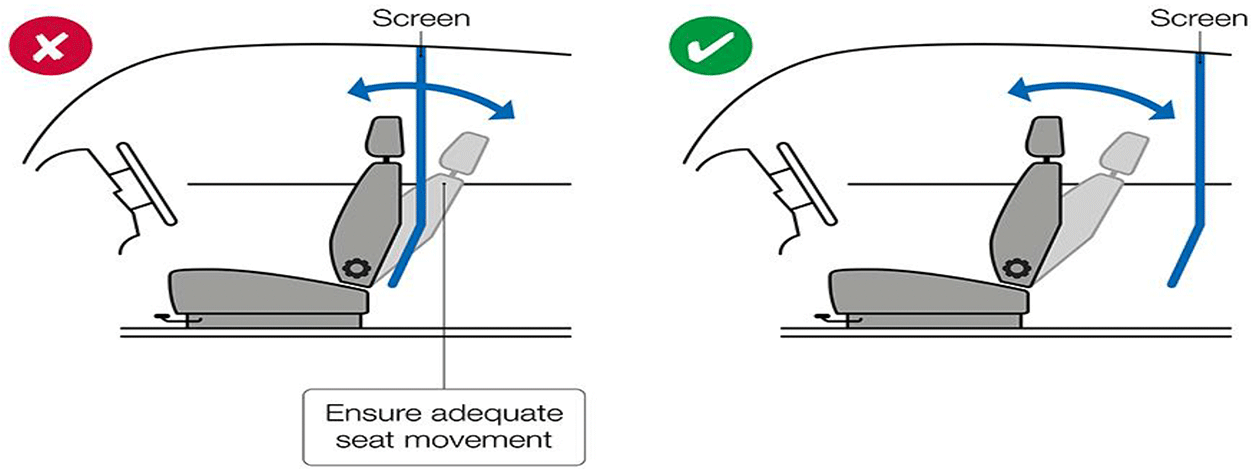Taxi and private hire car licensing: guidance - third edition
Best practice guidance for local licensing authorities and taxi and private hire car operators on the licensing of taxis and private hire cars and their drivers.
Annex C Non-statutory guidance – partition screens in taxis and private hire cars – July 2021 update
Overview
This non-statutory guidance provides advice for drivers, operators and owners of taxis or private hire cars who choose to fit a screen or barrier to their vehicle(s) to reduce the spread of coronavirus (COVID-19). In respect of partition screens only, this guidance supersedes previous guidance published in August 2020 by the Local Authority Environmental Health and Trading Standards Expert Officers' Group. Please note therefore the rest of the guidance published in August 2020 remains in place.
Fitting a screen can help to reduce the risk of virus transmission and should be one of a number of measures you consider.
The decision on whether to use a screen rests with you and the local licensing authority. This is because licensing of taxis and private hire cars is a local government responsibility. Before installing any screen you should check with your licensing authority if you need permission. Licensing authorities are able to, if they so wish, specify requirements that are different and/or go beyond the content of this non-statutory guidance.
However, if a licensing authority decides to specify requirements in respect of screens, they are encouraged to consider this guidance in developing their licensing requirements for the fitment of interior screens in a manner that is safe for the operation of vehicles and helps prevent the spread of coronavirus.
For the avoidance of doubt, the ultimate decision as to whether to specify requirements either different to and/or over and above those in this guidance rests with a licensing authority and this guidance does not in any way supersede the powers of licensing authorities in this area.
This guidance covers screens that are fitted to vehicles not originally designed to have a screen. It does not cover screens that are included in the vehicle as part of their original design.
1. Choosing a screen
There is a broad range of screens available, most of which are suitable for a variety of makes and models of vehicle. Any screen fitted to a vehicle must be made of suitable materials, manufactured to an acceptable standard of finish and installed by a competent person.
The choice of screen should be considered for each vehicle individually, because vehicle designs and specifications vary. Wherever possible, choose a screen offered or approved by the vehicle manufacturer to help ensure its suitability for your vehicle. Contact the vehicle manufacturer through a dealership or their website for advice on screen choice that is specific to your vehicle.
You should consider the following:
- if you're choosing a screen, you'll need to comply with any requirements set by your licensing authority
- ensure the screen is transparent and will not interfere with your vision while driving by obscuring rearward view in the internal mirror, or causing excessive reflection or distortion in that mirror or onto the windscreen
- the screen must not interfere with vehicle safety systems (for example, the airbags). Consider a screen that is flexible or has flexible borders that won't interfere with the deployment of side or curtain airbags
- the screen must not interfere with other vehicle safety systems, such as the seatbelts and their fixing points, seat back and head restraint operation
- check that screens and their fixings have no sharp edges or protrusions that might cause injury
- screens must be made of materials that do not have sharp edges if they break
- it's important to minimise the gap between the screen and the vehicle sides. Screens that fit the shape of the interior of the vehicle will be best at preventing transmission of coronavirus
- choose a screen that can be cleaned easily between passenger journeys. It should be rigid enough that it does not move much when cleaned
- check with the screen manufacturer to ensure the material used is neither toxic nor flammable
2. Fitting a screen
Screens may be fitted by a variety of automotive providers including vehicle manufacturer dealerships, specialist screen installers or you, if you have the skills and equipment to do so safely.
Whether you are getting a company to fit the screen, or are doing so yourself, the installation should be carried out in accordance with this guidance. As shown in figure 1, you should consider the: airbags; rear view mirror; head restraints; seat adjustments; and seatbelts and their fixing points

Ensure that the installation complies with the screen manufacturer's instructions.
Check that fixings do not interfere with a driver's rearward vision and, where there is flexibility to do so, ensure the screen is mounted to minimise reflections. A small change in the angle of the screen may help to avoid reflections, as shown in figure 2.

Ensure that any fittings to the vehicle do not compromise the safety and electrical systems on the vehicle. Hybrid and plug-in hybrid vehicles will have high voltage cables that may be hidden. Do not drill holes or make fixings to vehicle trim if you do not know what is behind a panel. Screens must be fitted so that they do not interfere with the operation of seats and head restraints as shown in figures 3a and 3b.


Ensure that seats can be adjusted to give a comfortable driving position, as shown in figures 4 and 5. Head restraints should not be removed.


The fitting of the screen must not prevent the correct operation of seatbelts. The seatbelt webbing should not chafe against the screen or the fixing points, or adversely affect the operation of seatbelt pretensioners.
The screen must not prevent the correct operation of active safety systems, such as airbags. This may be easier to achieve with a more flexible screen design.
Avoid the use of rigid fixings around airbags. Airbags may be identified through markings or labels on any of the following, as shown in figure 6: the steering wheel; front dashboard; seats; head restraints; trim panels; roof
You can also check the vehicle user manual or ask the vehicle manufacturer.

The screen must be fixed securely in the vehicle so that it will remain in place when the vehicle is driven with the windows open.
Entry and exit from the vehicle should not be made significantly more difficult due to the fitting of a screen. When fitting a screen, ensure that grab handles remain available for use by passengers and that doors are not obstructed.
The mobile app Euro Rescue contains centralised vehicle manufacturers' rescue sheets that provide information on the position of high voltage cables, airbags, seat belt pre-tensioners, for example, which may be helpful in carrying out a safe installation. It can be downloaded free of charge.
3. Communicating with passengers
Ensure you can talk with your passengers when a screen is fitted and consider the following:
- communication might be affected by the use of a screen
- think about how you communicate with disabled passengers
- passengers will be wearing a face covering, which will affect communication
- fitting an intercom system might be helpful if the screen would otherwise prevent adequate communication
- if stickers or notices are used to give information to passengers, these should not reduce the driver's view through front windows and windscreen, or their view of mirrors
4. Inform your insurance provider
Before you fit a screen to your vehicle, consider the following:
- inform your insurance provider. Failure to do so risks invalidating your policy
- the Association of British Insurers (ABI) encourages drivers and operators to seek guidance from their insurer to ensure compliance with the terms of their insurance policy
- check with your insurer whether, following a collision, screen repairs or a replacement screen would be included in your insurance cover
5. When a screen has been fitted
If a screen is fitted to your vehicle, consider the following:
- follow the manufacturer's instructions on maintenance of the screen
- check the screen regularly for cracks, deterioration and security of installation
- follow relevant guidance on cleaning the screen
- if the screen has an opening for payment, it should be closed or sealed during normal driving and only opened during the payment process
6. Definitions
In this guidance, 'you' or 'your' includes anyone who may be involved in choosing or fitting a screen in taxis and private hire cars.
'Screen' refers to a division or partition behind the front row seats to separate the driver from the passengers in the rear of the vehicle.
7. Legislation
The body of legislation governing road traffic law including the approval and use of vehicles is set out in the Road Traffic Act 1988, the Road Vehicle Approval Regulations 2020 and the Road Vehicles (Construction and Use) Regulations 1986.
All vehicles before being registered for use on roads in Great Britain need to be approved and any screen or partition fitted at the point of registration should be covered by the original vehicle approval.
Once the vehicle has been registered, the relevant legal requirements are Construction & Use (C&U). These regulations contain provisions that apply to all vehicles and components including requirements for the driver's view, materials for partitions and the general safety of drivers and passengers, all of which are relevant to the choice and installation of screens in taxis and private hire cars.
The guidance provides advice on the considerations you need to make to comply with these aspects of C&U. It remains the responsibility of those operating a vehicle or those providing vehicles or components to the market to ensure compliance with legislation.
The Equality Act 2010 places duties on drivers and operators of taxis and private hire cars with respect to disabled passengers and continues to apply where vehicles are fitted with screens or partitions.
This document is for guidance only. It's your responsibility to ensure your vehicle continues to comply with all appropriate road traffic legislation. In cases of doubt, you should seek your own legal advice.
Contact
Email: adam.sinclair@gov.scot
There is a problem
Thanks for your feedback